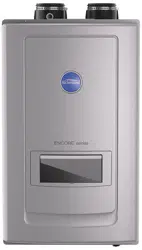Loading ...
Loading ...
Loading ...

AP18733 REV. 3.2.17
27
WARNING
DO NOT mix vent systems or materials unless specically told to do so in this manual.
DO NOT thermally insulate the exhaust vent or intake pipes.
DO NOT use an electric damper, vent damper, or draft hood with this water heater.
DO NOT locate the exhaust vent or intake pipe terminations where exposed to prevailing winds.
Moisture will be produced by the exhaust vent. Take precautions when determining exhaust vent termination. Moisture may fall from the vent
termination to the ground and turn to ice in freezing conditions. Moisture or ice can produce a hazardous condition.
Exhaust condensate is acidic, and could deteriorate the surface below the exhaust vent termination. Ensure this surface is in good repair (sealed,
painted, etc.) to prevent deterioration.
Failure to follow these instructions could result in property damage, severe personal injury, or death.
VENTING
DANGER
Vent this water heater in accordance with these instructions. Failure to do so will result in property damage, severe personal injury, or death.
▪ A. INTAKE PIPE AND EXHAUST VENT GUIDELINES
1. Vent system must be installed in accordance with local codes, or, in absence of
local codes, the National Fuel Gas Code, ANSI Z223.1 / NFPA 54 and/or CSA B149.1,
Natural Gas and Propane Installation Code.
2. For installation in Canada, installer supplied plastic vent piping must comply with
CAN/CGA B149.1 and be certified to the Standard for Type BH Gas Venting Systems,
ULC-S636. Components of this listed system must not be interchanged with other vent
systems or unlisted pipes or fittings. All plastic components and specified primers and
glues must be from a single system manufacturer and must not be intermixed with
another system manufacturer’s products. Clean and dry all applicable surfaces before
applying cement.
3. This water heater is designed to be installed in as a direct vent (sealed combustion)
type. In direct vent installations, combustion air must be supplied directly from the
outdoors to the burner, and the flue (exhaust) gases should be vented directly to the
outdoors through the wall or roof.
4. This water heater uses 2" (5.1 cm) or 3" (7.6 cm) diameter pipe for exhaust vent and
intake pipe. It is important to ensure an airtight seal from the water heater collar to the vent terminations. It is EXTREMELY IMPORTANT that the
maximum allowed combined venting lengths are not exceeded. See Table 11 for a list of Approved Vent Materials and Table 12 for Approved Vent
Lengths.
5. Do not install venting system components on the exterior of the building except as specifically required by these instructions.
• Vent terminals must be at least 1 foot (30 cm) from any door, window, or gravity inlet into the building.
• Maintain the correct clearance and orientation between the exhaust vent and intake pipe terminals.
• The exhaust vent and air intake terminals must be at the same height and their center lines must be spaced apart 1 foot (30 cm) minimum.
• The bottom of the exhaust vent and intake pipe terminals must be at least 1 foot (30 cm) above the normal snow accumulation level. In no
case should these terminals be installed less than 1 foot (30 cm) above normal snow accumulation level.
• Do not install the exhaust vent terminals directly above windows or doors.
• Intake pipe terminal must not terminate in areas that might contain combustion air contaminates, such as near swimming pools.
• For sidewall venting, the minimum horizontal distance between adjacent exhaust vent terminations is 1 foot (30 cm). It is recommended this
distance be greater than 1 foot (30 cm) to better avoid frost damage to building surfaces.
• For roof venting, minimum horizontal distance between any adjacent exhaust vent termination is 1 foot (30 cm).
• If the exhaust vent is to be terminated in a walled off area (such as a roof with a parapet wall), ensure the exhaust vent terminates a
minimum of 10' (3m) from nearest wall and extends level with or above the top of the wall. This will ensure flue gas does not get trapped
and possibly recirculated into the intake air pipe, which could contaminate the combustion air.
Loading ...
Loading ...
Loading ...
